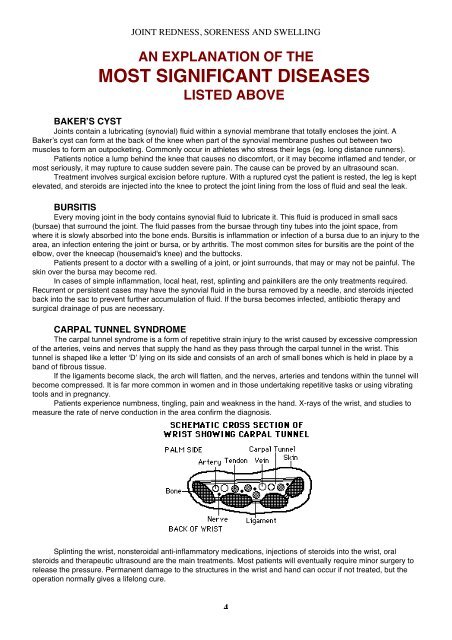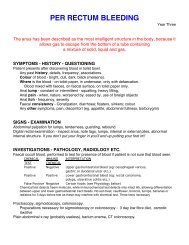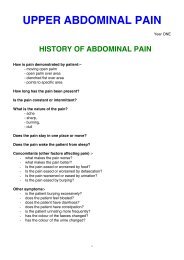RED, SORE, SWOLLEN JOINTS - Medwords.com.au
RED, SORE, SWOLLEN JOINTS - Medwords.com.au
RED, SORE, SWOLLEN JOINTS - Medwords.com.au
Create successful ePaper yourself
Turn your PDF publications into a flip-book with our unique Google optimized e-Paper software.
JOINT <strong>RED</strong>NESS, <strong>SORE</strong>NESS AND SWELLING<br />
AN EXPLANATION OF THE<br />
MOST SIGNIFICANT DISEASES<br />
LISTED ABOVE<br />
BAKER’S CYST<br />
Joints contain a lubricating (synovial) fluid within a synovial membrane that totally encloses the joint. A<br />
Baker’s cyst can form at the back of the knee when part of the synovial membrane pushes out between two<br />
muscles to form an outpocketing. Commonly occur in athletes who stress their legs (eg. long distance runners).<br />
Patients notice a lump behind the knee that c<strong>au</strong>ses no dis<strong>com</strong>fort, or it may be<strong>com</strong>e inflamed and tender, or<br />
most seriously, it may rupture to c<strong>au</strong>se sudden severe pain. The c<strong>au</strong>se can be proved by an ultrasound scan.<br />
Treatment involves surgical excision before rupture. With a ruptured cyst the patient is rested, the leg is kept<br />
elevated, and steroids are injected into the knee to protect the joint lining from the loss of fluid and seal the leak.<br />
BURSITIS<br />
Every moving joint in the body contains synovial fluid to lubricate it. This fluid is produced in small sacs<br />
(bursae) that surround the joint. The fluid passes from the bursae through tiny tubes into the joint space, from<br />
where it is slowly absorbed into the bone ends. Bursitis is inflammation or infection of a bursa due to an injury to the<br />
area, an infection entering the joint or bursa, or by arthritis. The most <strong>com</strong>mon sites for bursitis are the point of the<br />
elbow, over the kneecap (housemaid's knee) and the buttocks.<br />
Patients present to a doctor with a swelling of a joint, or joint surrounds, that may or may not be painful. The<br />
skin over the bursa may be<strong>com</strong>e red.<br />
In cases of simple inflammation, local heat, rest, splinting and painkillers are the only treatments required.<br />
Recurrent or persistent cases may have the synovial fluid in the bursa removed by a needle, and steroids injected<br />
back into the sac to prevent further accumulation of fluid. If the bursa be<strong>com</strong>es infected, antibiotic therapy and<br />
surgical drainage of pus are necessary.<br />
CARPAL TUNNEL SYNDROME<br />
The carpal tunnel syndrome is a form of repetitive strain injury to the wrist c<strong>au</strong>sed by excessive <strong>com</strong>pression<br />
of the arteries, veins and nerves that supply the hand as they pass through the carpal tunnel in the wrist. This<br />
tunnel is shaped like a letter ‘D’ lying on its side and consists of an arch of small bones which is held in place by a<br />
band of fibrous tissue.<br />
If the ligaments be<strong>com</strong>e slack, the arch will flatten, and the nerves, arteries and tendons within the tunnel will<br />
be<strong>com</strong>e <strong>com</strong>pressed. It is far more <strong>com</strong>mon in women and in those undertaking repetitive tasks or using vibrating<br />
tools and in pregnancy.<br />
Patients experience numbness, tingling, pain and weakness in the hand. X-rays of the wrist, and studies to<br />
measure the rate of nerve conduction in the area confirm the diagnosis.<br />
Splinting the wrist, nonsteroidal anti-inflammatory medications, injections of steroids into the wrist, oral<br />
steroids and therapeutic ultrasound are the main treatments. Most patients will eventually require minor surgery to<br />
release the pressure. Permanent damage to the structures in the wrist and hand can occur if not treated, but the<br />
operation normally gives a lifelong cure.<br />
4









